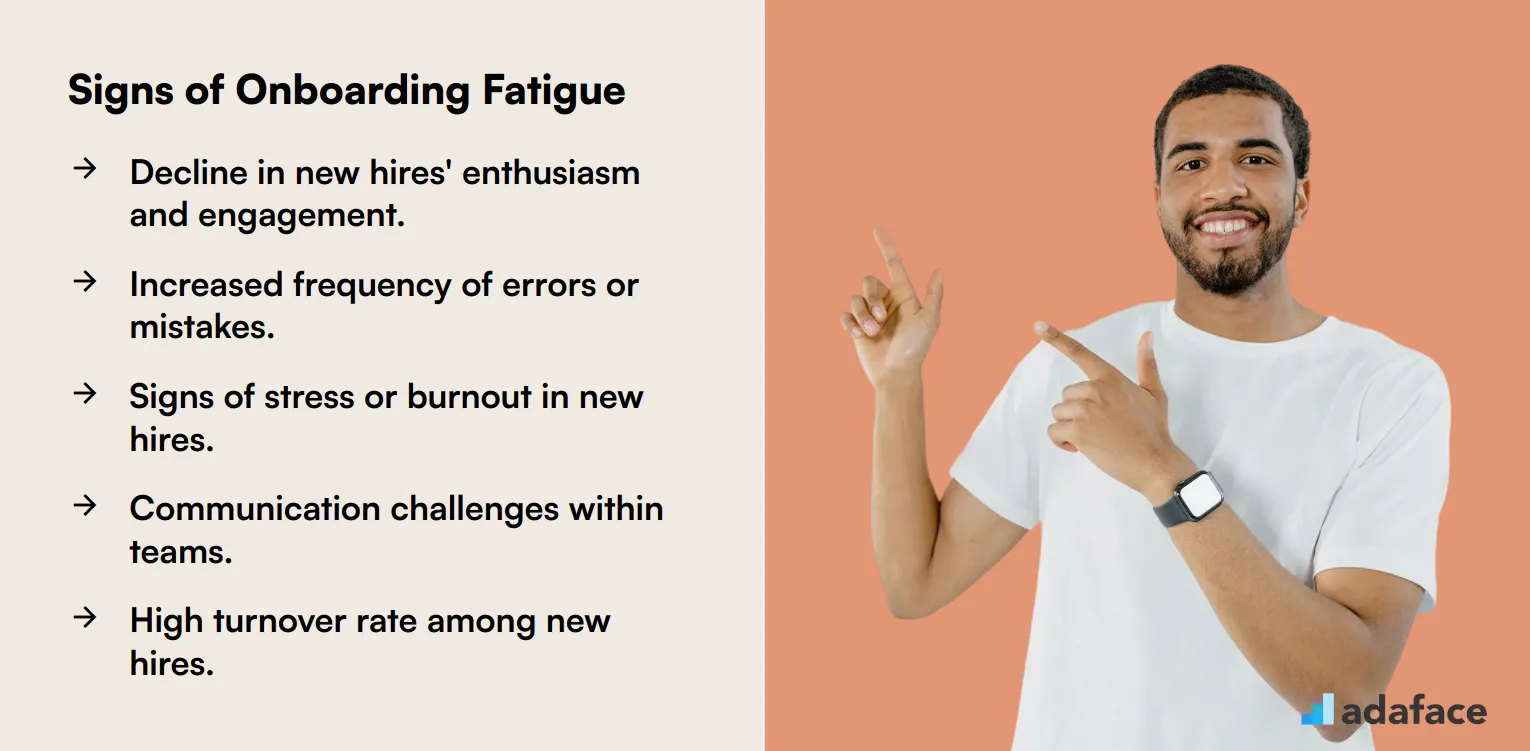Onboarding fatigue is a growing concern for recruiters and employers. It occurs when new hires feel overwhelmed during the onboarding process, leading to decreased engagement and productivity. Enhancing candidate experience is crucial to mitigate this issue.
Recognizing and addressing onboarding fatigue is essential for retaining talent. By understanding its causes and effects, recruiters can implement strategies to create a smoother onboarding experience for new employees.
Table of contents
What is onboarding fatigue?
Onboarding fatigue is a phenomenon where new employees feel overwhelmed and exhausted during their initial period at a company. It occurs when the onboarding process is too long, complex, or information-heavy, leading to decreased engagement and productivity.
New hires experiencing onboarding fatigue may struggle to retain important information and feel less connected to their role or the organization. This can result in slower integration, reduced job satisfaction, and potentially higher turnover rates in the early stages of employment.
Signs of onboarding fatigue include difficulty concentrating, decreased enthusiasm, and a sense of being overwhelmed by new information and tasks. Employees may also show reluctance to ask questions or seek help, fearing they might appear incompetent or unprepared for their new role.
To combat onboarding fatigue, companies should focus on creating a streamlined, engaging, and well-paced onboarding experience. This can involve breaking down information into digestible chunks, using interactive learning methods, and providing ample opportunities for new hires to practice and apply their newly acquired knowledge.
Effective onboarding should balance necessary information with opportunities for social integration and hands-on learning. By doing so, organizations can help new employees feel more comfortable, confident, and ready to contribute to their teams and the company as a whole.
Common signs of onboarding fatigue
Onboarding fatigue often reveals itself through a range of subtle yet impactful signs. One common sign is a noticeable decline in new hires' enthusiasm and engagement, which can lead to decreased productivity and morale.
Another indicator is the increased frequency of errors or mistakes made by recently onboarded employees. This can stem from overwhelming information overload or unclear expectations during the onboarding process.
Additionally, new hires may exhibit signs of stress or burnout, such as frequent absences or a reluctance to participate in team activities. This can be exacerbated by inadequate support or resources provided during their initial days.
Communication challenges can also signal onboarding fatigue, with new employees struggling to connect or collaborate effectively with their teams. This may result from a lack of proper introductions or integration into the company culture.
Lastly, a high turnover rate among new hires can be a red flag, indicating that the onboarding process is not meeting their needs or expectations. Addressing these signs early on is important to ensure a smoother transition and long-term success for new employees.

Causes of onboarding fatigue
Onboarding fatigue can stem from various sources, impacting the new hire's enthusiasm and productivity. Understanding these causes is the first step in mitigating this challenge and creating a more positive onboarding experience, much like addressing problems in recruitment and selection process. Let's explore the common culprits behind onboarding fatigue.
One major cause is information overload. Bombarding new hires with too much information at once can be overwhelming, leading to confusion and disengagement. A better approach is to break down the onboarding process into manageable chunks, providing information progressively.
Repetitive or irrelevant training also contributes significantly. New hires may feel their time is being wasted if they're forced to sit through training sessions that don't align with their job roles or skill levels. Personalizing the onboarding experience to address individual needs and skill gaps can help combat this.
Lack of social integration is another key factor. New hires need opportunities to connect with their colleagues and build relationships to feel like they're part of the team. Facilitating social interactions and team-building activities can promote a sense of belonging and reduce feelings of isolation.
Finally, poor communication and lack of feedback can exacerbate onboarding fatigue. New hires need clear expectations, regular check-ins, and constructive feedback to stay motivated and on track. Establishing open communication channels and providing ongoing support can help new hires feel valued and supported.
Effects of onboarding fatigue on new hires
Onboarding fatigue can significantly impact new hires, leading to decreased motivation and engagement. When overwhelmed by excessive information and tasks, new employees may struggle to integrate into the company culture, affecting their overall productivity.
This fatigue can also result in higher turnover rates, as new hires may feel unsupported and choose to leave the organization. The lack of proper onboarding can make them feel isolated, reducing their commitment to the company.
Moreover, onboarding fatigue can hinder the development of transferable skills that are crucial for employees to succeed in their roles. Without adequate support, new hires might miss opportunities to learn and grow within the organization.
The effects of onboarding fatigue extend beyond the individual, impacting team dynamics and overall workplace morale. When new hires are not effectively integrated, it can create friction and miscommunication within teams.
Addressing onboarding fatigue is crucial for fostering a positive work environment and ensuring the long-term success of new employees. By simplifying and personalizing the onboarding process, companies can help new hires feel more welcomed and supported.
Strategies to combat onboarding fatigue
Onboarding fatigue can feel like running a marathon with no finish line, but thankfully, there are strategies to make the process smoother. Let's explore some ways to combat this challenge and create a more engaging experience.
Prioritize Pre-boarding: Start engaging new hires even before their first day. Send welcome packages, introduce them to team members, and provide access to introductory materials.
Chunk Information: Avoid overwhelming new hires with too much information at once. Break down the onboarding process into smaller, manageable modules spread over time.
Use Technology: Leverage digital tools for onboarding, such as interactive training platforms and communication channels. This can streamline the process and make it more engaging, and can be a great way to implement digital onboarding.
Assign a Buddy: Pair new hires with a buddy or mentor who can provide support and guidance. This helps them integrate into the team and company culture more quickly.
Gather Feedback: Regularly solicit feedback from new hires about their onboarding experience. Use this feedback to identify areas for improvement and make adjustments accordingly.
Gamify the Experience: Incorporate game-like elements into the onboarding process to make it more fun and engaging. This can include quizzes, challenges, and rewards to motivate new hires and reinforce learning.
Personalize the Experience: Tailor the onboarding process to the individual needs and preferences of each new hire. This shows that you value them as individuals and are invested in their success.
By implementing these strategies, you can combat onboarding fatigue and create a more positive and productive experience for new hires. Remember, a well-designed onboarding program sets the stage for long-term employee success.
Best practices for a smooth onboarding process
A smooth onboarding process is key to reducing employee fatigue and setting new hires up for success. Start by creating a comprehensive onboarding checklist that covers all necessary tasks and information. This ensures nothing important is overlooked and provides structure for both the new employee and the onboarding team.
Prepare a welcoming environment before the new hire's first day. This includes setting up their workspace, preparing necessary equipment, and informing team members about the new arrival.
Provide clear expectations and goals for the new employee's first few weeks and months. This helps them understand their role and how they fit into the larger organization.
Assign a mentor or buddy to help the new hire navigate their first weeks on the job. This person can answer questions, provide guidance, and help the new employee feel more comfortable in their new environment.
Gradually introduce new responsibilities and information to avoid overwhelming the new hire. Break down complex tasks into manageable chunks and provide ample time for learning and adjustment.
Regularly check in with the new employee to gather feedback and address any concerns. This shows that you value their input and are committed to their success in the organization.
Conclusion
Onboarding fatigue is a challenge that can impact both new hires and organizations. By recognizing its signs and understanding its causes, HR professionals can take proactive steps to mitigate its effects.
Implementing strategies and best practices can lead to a more positive onboarding experience. This not only benefits new employees but also enhances overall organizational effectiveness.
Remember, a smooth onboarding process is key to setting the stage for long-term success. Let's make onboarding a welcoming journey rather than a hurdle.
Onboarding Fatigue FAQs
Employers can prevent employee ghosting by maintaining clear and open communication, setting realistic job expectations, and providing a supportive onboarding experience.
Ghosting is on the rise due to increased job options for candidates and a lack of engagement during the recruitment process. Creating a positive candidate experience can reduce this trend.
Common signs of onboarding fatigue include decreased enthusiasm, lack of engagement, and slower adaptation to the company culture and processes.
Onboarding fatigue can lead to reduced productivity, lower job satisfaction, and increased turnover rates among new hires.
To combat onboarding fatigue, streamline the onboarding process, provide clear guidance, and offer ongoing support and feedback to new hires.
Best practices include personalizing the onboarding experience, setting clear expectations, and fostering a welcoming company culture.

40 min skill tests.
No trick questions.
Accurate shortlisting.
We make it easy for you to find the best candidates in your pipeline with a 40 min skills test.
Try for freeRelated terms



